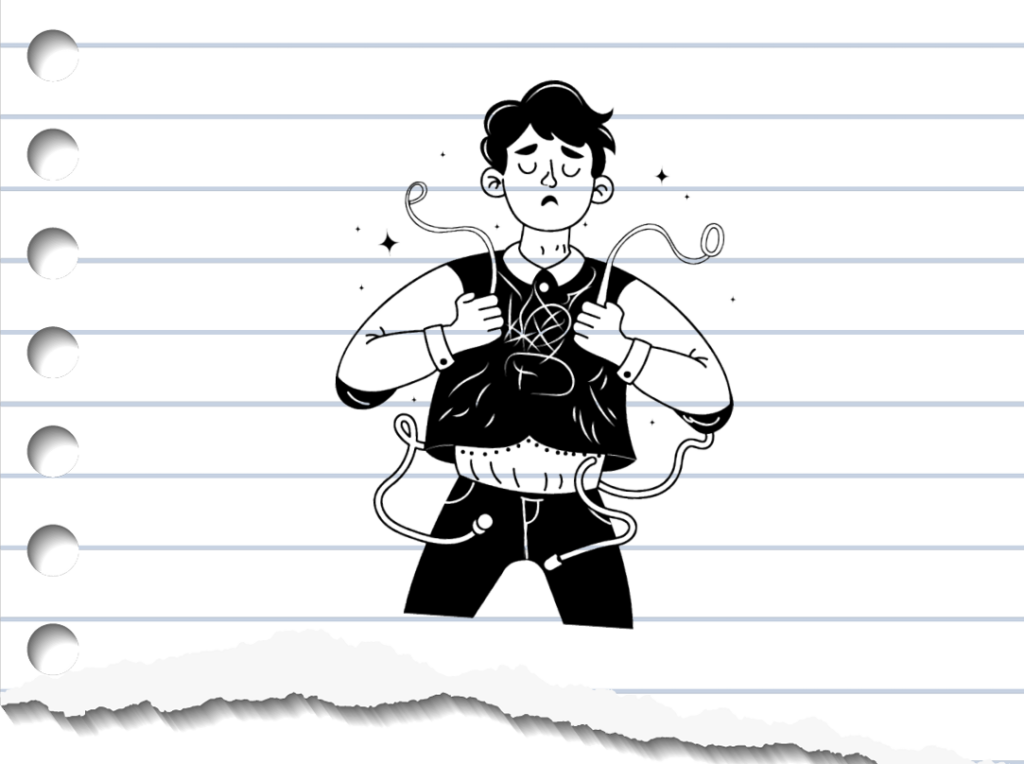
What if something I said to that First Officer last year still bothers them? What if that comment I made about their procedure has created tension between us that I have not even noticed? What if I missed a crucial detail during the pre-flight briefing that could compromise the safety of the flight, and I did not catch it at the time? It is natural to replay conversations or decisions like these in your mind, especially when you are unsure of the impact they might have had. However, when this kind of rumination takes over, it can spiral into endless “what-ifs” that drain your energy and productivity. Do you often lie awake at night, rehashing past interactions or second-guessing your choices? This article offers practical strategies to help you break free from the cycle of rumination and regain your peace of mind.
Rumination is the habit of getting stuck in a cycle of overthinking past events, mistakes, or worries. It is a deeply human response, where we endlessly replay situations in our minds, trying to make sense of them or to avoid future mistakes. Studies show that around 40-50% of people regularly ruminate, often fixating on personal relationships, past errors, or awkward social moments (Joormann & Vanderlind, 2014; Ramel & Gross, 2022). This mental loop typically shows up as a constant inner dialogue, filled with “what if” scenarios or self-criticism like, “Why did I say that?” or “I should've done it differently.” People might also find themselves mentally obsessing over negative experiences, analyzing them from every angle, and trying (often unsuccessfully) to make sense of them.
While reflecting on the past is normal, chronic rumination can make it hard to focus on anything else, and it typically increases feelings of stress, guilt, and sadness and contributes to anxiety or depression, as it keeps you trapped without offering real solutions or closure.
Rumination vs. Worrying
Rumination and worrying both involve repetitive thinking, but they differ in focus and impact. Rumination typically revolves around past events, often dwelling on mistakes, regrets, or things we could have done differently. It is a kind of mental replay that does not lead to problem-solving, but instead keeps emotions stuck in the past. Worrying, on the other hand, is more future-oriented, involving anxiety about what might go wrong or potential problems that have not yet occurred. While both can be distressing, rumination tends to reinforce negative emotions, whereas worrying is often rooted in uncertainty and anticipation of challenges that may or may not happen.

Why Do We Ruminate?
At its core, rumination is a coping mechanism. When people feel distressed, their mind may fixate on what’s troubling them, whether it’s a stressful situation, a regretful memory, or an overwhelming feeling. Instead of finding a solution or taking action, the focus remains on the distress itself. This process can feel like an attempt to gain control or make sense of the situation, but it usually does not lead to problem-solving.
Consequences of Rumination
When rumination becomes chronic, it can have a range of negative effects on both mental and physical health, including:
Increased Anxiety: Constantly thinking about potential dangers or worst-case scenarios can heighten stress.
Depressive Feelings: Rumination often reinforces negative emotions, leading to feelings of helplessness and sadness.
Cognitive Impairment: Ruminating can impair concentration and problem-solving abilities, making it harder to focus on tasks.
Fatigue: The mental effort of repetitive thinking can lead to mental exhaustion.
Sleep Disturbances: Since the mind remains active and stuck on the same thoughts, it can interfere with falling or staying asleep.
Social Isolation: As rumination tends to focus inward, individuals may withdraw from social interactions, further exacerbating feelings of loneliness.
How to Stop Ruminating Without Therapy or Medication
If you are looking to stop ruminating by yourself, there are several strategies you can try. These techniques and exercises can help you break the cycle of repetitive thinking and regain control of your mind. Here are some practical methods:
Distraction: Engage in activities that fully capture your attention, such as exercising, cooking, reading, or doing a puzzle.
Journaling: Write down your thoughts and feelings. Journaling helps externalize your worries and offers a safe space to process emotions.
Mindful Breathing: Practice deep breathing exercises to calm your body and mind. Focus on your breath to center yourself in the present moment.
Scheduled “Worry Time”: Set aside a specific time each day, such as 15 minutes, to actively think about and problem-solve any worries. Outside of this time, gently remind yourself that it is not the moment to ruminate.
Self-Compassion: Be kind to yourself. Acknowledge that it is natural and okay to have negative thoughts but remind yourself that you do not have to be defined by them.
Physical Activity: Engage in physical exercises, like walking, yoga, or dancing, which can release endorphins and shift your focus away from distressing thoughts.
Exercise 1: The Five-Minute Grounding Technique
This quick grounding exercise can help interrupt rumination in the moment. It uses mindfulness to bring you back to the present and calm the mind:
- Stop and Breathe: Sit comfortably or stand still. Close your eyes if you feel comfortable doing so.
- Ground Yourself: Focus on the physical sensations of your body. Feel your feet on the ground, your back against the chair, or your hands resting on your lap.
5-4-3-2-1 Technique: Identify:
- 5 things you can see (e.g., a clock, a plant, the sky, a piece of furniture, a book).
- 4 things you can feel (e.g., your feet touching the floor, the texture of your clothing, the air on your skin, your heartbeat).
- 3 things you can hear (e.g., birds chirping, a ticking clock, the hum of an appliance).
- 2 things you can smell (e.g., coffee, fresh air, a candle).
- 1 thing you can taste (e.g., the aftertaste of a meal or drink, or a fresh mint).
- Focus on Your Breath: Take deep, slow breaths in through your nose and out through your mouth. Repeat for a minute or two.
This exercise helps shift your focus from ruminative thoughts to your physical surroundings, bringing you into the present moment and reducing the power of intrusive thoughts.
Exercise 2: ACT Exercise
A recent approach is ACT (Acceptance and Commitment Therapy), which involves accepting that emotions are “real” and consciously choosing to think and feel differently. It is not wrong to experience “negative” emotions; view them as signals of underlying struggles and reflect on them.
This exercise offers a structured way to break the cycle of rumination. By first accepting and observing emotions without judgment (Acceptance), you avoid getting stuck in negative thought patterns. Choosing a positive direction and focusing on progress (Direction) shifts the focus away from past mistakes and overanalyzing what can’t be changed. Finally, committing to action (Action) reinforces resilience and the importance of moving forward, preventing the mind from spiraling back into rumination. This combination of mindfulness and proactive thinking helps stop the repetitive thinking that often fuels rumination.
Example: Imagine a pilot, during a pre-flight briefing, mistakenly says, “We will be cruising at 38,000 feet today,” when in fact the flight plan specified 35,000 feet. The first officer does not correct them, and the briefing continues without issue. Later, as the flight progresses, the pilot starts to ruminate on the mistake, thinking, “What if I caused confusion for the crew? What if that small error affects the flight plan later on?” The pilot might replay the situation in their mind, worrying about the potential consequences and how others might perceive their professionalism, even though there was no actual impact.
The pilot can apply this exercise to break the cycle of rumination about their mistake during the briefing.
Acceptance: First, the pilot acknowledges the feelings of discomfort or self-doubt without judgment—recognizing that making mistakes is part of being human. Instead of criticizing themselves, they simply observe the emotions that arise, such as embarrassment or worry, without getting caught up in them.
Direction: Next, they choose to focus on the positive steps they can take moving forward. They remind themselves that the flight is proceeding smoothly, and that they are capable of handling any potential issues that arise. The pilot refocuses on the present moment—such as checking flight data or coordinating with the crew—rather than dwelling on the past mistake.
Action: Finally, the pilot commits to staying resilient and flexible. If any confusion arises due to the mistake, they will address it calmly and professionally. By choosing to focus on what they can control (like effective communication with the crew or following standard protocols), they actively reinforce the importance of moving forward rather than replaying the error.
By applying these steps, you can avoid getting stuck in a cycle of rumination, shifting your focus from what went wrong to what you can do now to keep the flight running smoothly.

Final Thoughts
Rumination is a common mental pattern that many people experience, especially when faced with stress or emotional discomfort. While it can offer temporary comfort in regaining a sense of control, it often deepens anxiety, depression, and other mental health challenges. Recognizing when rumination is taking hold is an important first step in breaking the cycle. With the right exercises or therapeutic interventions, you can learn to manage your thoughts more effectively, reduce stress, and enhance your overall well-being.
Are you struggling with rumination or feeling overwhelmed by persistent, repetitive thoughts? Emerald Mental Health offers individual coaching and therapy for pilots and aviation professionals designed to help you break free from the cycle of overthinking and develop healthier mental patterns. A personalized approach can guide you in managing stress, building resilience, and enhancing your emotional well-being. Reach out for a free consultation by emailing reini@emeraldmentalhealth.com or visit www.emeraldmentalhealth.com to learn more.
Resources
Joormann, J., & Vanderlind, W. M. (2014). Emotion regulation in depression and anxiety: The role of rumination. Emotion, 14(5), 927–937. https://doi.org/10.1037/a0036761
Ramel, W., & Gross, J. J. (2022). Cognitive and emotional consequences of rumination: A review. Frontiers in Psychology, 13, 767829. https://doi.org/10.3389/fpsyg.2022.767829






















































































































